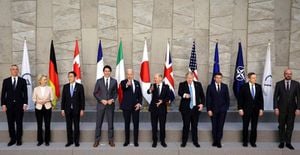On February 24, 2022, the world watched as Russia launched its full-scale invasion of Ukraine, plunging Europe back to the shadows of war. Fast forward to now, as we mark the distressing milestone of 1,000 days of conflict, the repercussions of these actions have echoed far beyond the initial flashpoints of violence. Lives have been irrevocably altered, and international relations have become increasingly complicated.
Recent reports from Ukraine's Prosecutor General's Office paint a grim picture. Since the invasion began, over 13,585 civilians have been confirmed either killed or injured, highlighting the extensive human suffering inflicted by the Russian military. This staggering statistic reflects not just the immediate impact of warfare but also the devastating toll exacted on non-combatants caught in the crossfire.
The Ukraine conflict has systematically led to widespread destruction of civil infrastructure. More than 156,000 residential buildings have been damaged or destroyed as rockets and missiles rain down from the skies, leaving countless families homeless. Educational institutions, medical facilities, and cultural landmarks are among the numerous sites targeted, effectively crippling the country’s societal framework. Reports confirm significant assaults on educational institutions, with 3,691 schools reported hit, putting the future of countless Ukrainian children at risk.
The weaponry employed by invading forces has often skirted the bounds of legality, incorporating banned munitions such as mines and chemical agents, which violate international laws of war. Since the beginning of this invasion, Russian forces have orchestrated 606 attacks on over 220 power generation facilities, fueling a crippling energy crisis. And it’s not just the infrastructure being damaged; thousands of individuals, particularly the youngest and most vulnerable, have borne the brunt of this violence.
This humanitarian crisis intensifies when one considers the plight of children. Alongside the thousands injured or killed, Ukrainian authorities document numerous instances of forced deportation and unlawful detention of minors, emphasizing the sheer scope of these atrocities. The war has not only disrupted their education but stripped them of their childhood.
Government officials contest the narrative surrounding Russia’s commitment to the war, seeing it instead as widespread violations of human rights and international law. These claims are actively pursued with extensive investigations being undertaken by Ukraine's Prosecutor General’s Office. To date, over 168,299 offenses linked to Russian aggression have been documented, with 143,906 categorized explicitly as war crimes. These include willful killings, plunder, and indiscriminate attacks—a stark reminder of the horrific consequences of the conflict.
The military dynamics of the situation remain precarious, with recent developments including President Biden's controversial decision to allow Ukraine to strike targets inside Russia utilizing U.S.-supplied long-range missiles. This tactic, termed as potentially provocative by some, springs from mounting tensions on the battlefield. The U.S.'s Army Tactical Missile System (ATACMS), with its potential to reach far beyond the active front lines, has sparked concerns within the Russian governmental hierarchy.
On this sensitive front, Kremlin officials reacted swiftly to Biden's policy shift. Dmitry Peskov, Russia’s spokesperson, expressed fears about the resulting escalation, claiming it would “add fuel to the fire” of the current conflict. The implication of allowing Ukraine the capability to counter-attack within Russian borders rattles nervously within the Russian establishment, as many officials and lawmakers voiced their outright condemnation.
“This decision not only changes the stakes of the conflict but could be viewed as direct participation by NATO forces,” said Russian Senator Vladimir Dzhabarov. Such remarks underline the deep-seated anxieties within Russian leadership, fearing the possibility of external powers significantly increasing their operational involvement. The Kremlin has signaled its view of these actions as tantamount to war declarations against Russia, reinforcing the narrative of their struggle against perceived Western hegemony.
Adding another layer of complexity, North Korean troops have reportedly entered the conflict areas alongside Russian forces, raising alarms among Western military analysts. This involvement begs the question: how deep will the alliances stretch? The intersection of these geopolitical strains complicates the picture for both the U.S. and its allies.
Ukraine, on the frontlines of this grueling conflict, continues to push back against Russian advances, albeit facing significant challenges. The continuous barrage of Russian artillery has pressured Ukraine's defending forces, particularly within the eastern Donetsk region, where Russian troops seem to be slowly gaining ground. Despite these harrowing circumstances, Ukrainian President Volodymyr Zelenskyy remains resolute, stating, “The missiles will speak for themselves.” His administration views the capability to strike back as integral to shortening the conflict's duration.
International responses to the U.S.'s pivot have been mixed. The developments have reinvigorated discussions among NATO members, some of whom see this as an overdue acknowledgment of the war's severity. For example, Polish President Andrzej Duda praised Biden’s decision, asserting it as potentially monumental for Ukraine’s chances. Duda pointed out, “We have seen the decisive intensification of Russian attacks on Ukraine, above all, those missile attacks where civilian objects are attacked.”
Conversely, pro-Russian leaders in Slovakia denounced the U.S. decision as “unprecedented escalation,” illustrating the sharply divided perspectives on how best to handle the conflict. The Slovakia Prime Minister's remarks signify how regional ramifications are potentially shifting stances on military support for Ukraine.
Despite the growing military assistance from the U.S. and its allies, experts caution against equipping Ukraine with arms without considering its logistical needs, urging the necessity for ample stockpiles to match ambitious operational goals. Analysts express doubt about whether these moves will significantly alter the conflict's course, but they do recognize the morale boost for Ukrainian forces.
While hopes for peace remain fragile and elusive, the escalation of military involvement continues to spur discussions about the future. With the path forward uncertain, one thing is clear: the long-term consequences of the decision to arm Ukraine against Russian aggression will undoubtedly reshape the geopolitical landscapes for decades. Global power dynamics are shifting, alliances are being tested, and ordinary civilians continue to suffer the fallout from decisions made far from the battlefield.
Reflecting on these 1,000 days of violence, destruction, and suffering, questions loom over whether the international community can come together to curtail this aggression. The human cost lays heavy as civilians grapple with the devastation wrought upon their lives. Every retaliatory strike and change of policy reverberates through cities and villages awaiting the return of peace—a peace still just out of reach.



